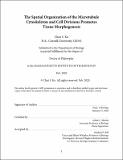| dc.contributor.advisor | Adam C. Martin. | en_US |
| dc.contributor.author | Ko, Clint S. | en_US |
| dc.contributor.other | Massachusetts Institute of Technology. Department of Biology. | en_US |
| dc.date.accessioned | 2020-09-25T20:02:52Z | |
| dc.date.available | 2020-09-25T20:02:52Z | |
| dc.date.copyright | 2020 | en_US |
| dc.date.issued | 2020 | en_US |
| dc.identifier.uri | https://hdl.handle.net/1721.1/127696 | |
| dc.description | This electronic version was submitted by the student author. The certified thesis is available in the Institute Archives and Special Collections. | en_US |
| dc.description | Thesis: Ph. D., Massachusetts Institute of Technology, Department of Biology, 2020 | en_US |
| dc.description | Cataloged from student-submitted PDF version of thesis. | en_US |
| dc.description | Includes bibliographical references. | en_US |
| dc.description.abstract | During embryonic development, epithelial tissues grow and become sculpted into complex shapes through highly coordinated cell behaviors, such as cell shape change and cell division. Both processes involve contractile forces generated from distinctly organized actomyosin networks. How cells coordinate their behaviors and how different cell behaviors interact to affect tissue shape remain long-standing questions in developmental biology. One way that a single cell behavior can be coordinated, such as during collective cell shape changes (apical constriction), is through the attachment of actomyosin networks in each cell to adherens junctions, allowing contractile forces to be integrated across the epithelium. However, how actomyosin connections to junctions are maintained during morphogenesis is poorly understood. | en_US |
| dc.description.abstract | In this thesis, I demonstrate that a novel organization of non-centrosomal microtubules plays an essential role in stabilizing force transmission between apically constricting cells in the early Drosophila embryo. Microtubule organization promotes apical F-actin meshwork turnover near junctions, which allows actomyosin to rapidly reattach to junctions when connections are lost. I find that actomyosin contractility drives the organization of non-centrosomal microtubules in apically constricting cells, uncovering crosstalk between F-actin and microtubule networks that serves to organize the apical cortex, stabilizing force transmission between cells. In addition, I investigate how coordination of apical constriction with another cell behavior--cell division--can influence the final shape of tissues. I show that cell division antagonizes apical constriction by disrupting medioapical contractile signaling. | en_US |
| dc.description.abstract | Cell divisions that occur in the same time and place as apical constriction interfere with tissue internalization. However, when mitotic cells neighbor contractile cells, mitotic entry relaxes the apical cortex relative to neighboring cells, causing a force imbalance that allows surrounding cells to apically constrict. Mitotic cell relaxation then allows constricting cells to internalize, illustrating another mechanism by which cell divisions can shape tissues. This thesis highlights the significance of a novel cytoskeletal organization that coordinates apically constricting cells. In addition, apical constriction and cell division can interact in different ways to impact final tissue shape. | en_US |
| dc.description.statementofresponsibility | by Clint S. Ko. | en_US |
| dc.format.extent | 145 pages | en_US |
| dc.language.iso | eng | en_US |
| dc.publisher | Massachusetts Institute of Technology | en_US |
| dc.rights | MIT theses may be protected by copyright. Please reuse MIT thesis content according to the MIT Libraries Permissions Policy, which is available through the URL provided. | en_US |
| dc.rights.uri | http://dspace.mit.edu/handle/1721.1/7582 | en_US |
| dc.subject | Biology. | en_US |
| dc.title | The spatial organization of the microtubule cytoskeleton and cell divisions promotes tissue morphogenesis | en_US |
| dc.type | Thesis | en_US |
| dc.description.degree | Ph. D. | en_US |
| dc.contributor.department | Massachusetts Institute of Technology. Department of Biology | en_US |
| dc.identifier.oclc | 1196085674 | en_US |
| dc.description.collection | Ph.D. Massachusetts Institute of Technology, Department of Biology | en_US |
| dspace.imported | 2020-09-25T20:02:51Z | en_US |
| mit.thesis.degree | Doctoral | en_US |
| mit.thesis.department | Bio | en_US |
